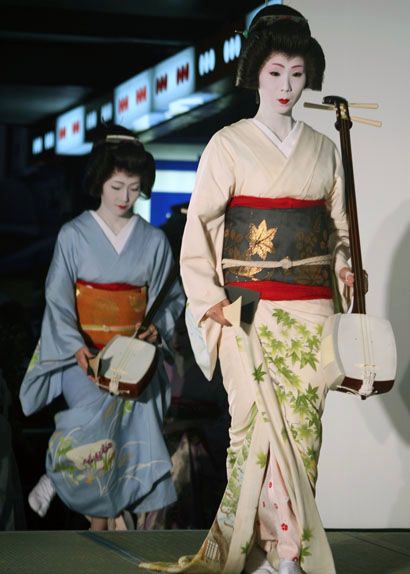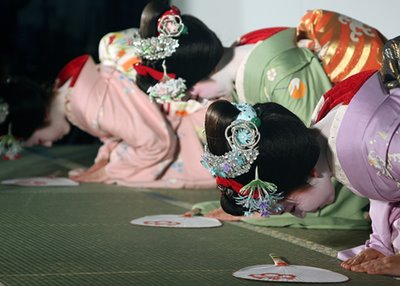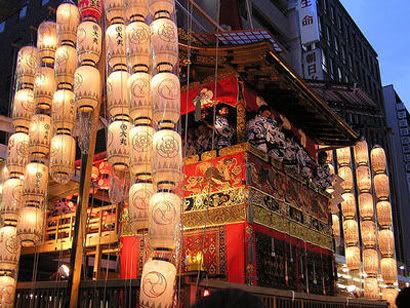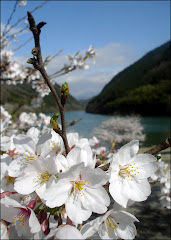
No, I haven`t dyed my hair
a las Hilton heiresses. This is much more serious.
I`ve become addicted....to Anime. Well, one anime in particular.
BLEACH."So what? No big deal! Anime is anime-zing! " You might say, but to be honest, I was about as Anti-Anime as anyone could be. I vaguely remember watching the classic Akira with my older brother as a junior high schooler, and promptly forgetting it ever existed. I also recall trying to pass the 4 hours of complete and utter bordem afforded by my Saturday detention (part of my punishment for 'inciting a riot and being obligerent to an officer` in my cheerleading uniform) by sketching a wide-eyed, anime-style girl, although I don't know what posessed me to do so. Other than Akira, my Asian exposure was almost nonexistant, and I made little effort to rectify my ignorance on the subject. For one thing I was too busy concentrating on other cultures and forms of art, speaking Spanish, escaping to Mexico, playing softball and any other sport the boys would let me get in on, cheerleading, or partying. Japan was an exotic land of sushi eating samurai and geisha on ketais (cell phones), lost in a neon colored concrete jungle...And it was the last place I ever thought I`d end up.

I'm not sure why or how, but by the time events had conspired to send me to Japan as a study abroad student (my senior year of university), I had somehow formed a rather unfavorable opinion of anime (despite of my lack of information on the subject) . I was shocked to find that at least half of the gaijin students at Kansai Gaidai had come to Japan with the expressed intent of watching anime they couldn`t see in their home countries. While the other half of us explored the adventure-filled streets of Kyoto and Osaka with our new Japanese tomodachi, they stayed in the dorms watching anime, or dressed up in their Cosplay-best and headed to the nearest gathering of anime otaku (dorks, nerds, freaks).
Japan's culture and customs were basically brand spankin' new to me. I had been transported from a land where cartoons and comics were mostly for small children, to a hardcore manga metropolis where everyone from the ojiisan's (old men) waiting for the next bus, to my university-aged boyfriend, stood in cornerstore conbini's for what seemed like forever, viewing the newest, phonebook-sized releases of their favorite comics. Buisnessmen in gloomy black suits shamelessly scanned page after page of manga on crowded trains, even when they were blatantly pornographic. Sexy depictions of young girls in school uniforms and the shady, smiling, salarymen staring at them seemed to me to be the source of the problematic tsukebe and chikan (perverts) obsessed with anonymously violating women on crowded trains, not to mention the endless score of old men that paid young girls to 'play' with them (enjou kosai).
The original opening for Bleach to one of my favorite Japanese songs: *ASTERIK* by Orange Range.
The connection stuck. Needless to say, I made it through an entire 3 and a half months of study in Japan without ever reading manga or watching anime, not to mention the 3 years since then. In fact I was irritated when, during my breif visit back home for a friends wedding, I found an entire section devoted to Anime at a Borders book store. Shelf after shelf of big-eyed, big-breasted, long-legged school girls, in sailor uniforms, with super-short skirts and clothes molded to every curvey contour of their illustrated bodies.
The seemingly huge success of anime in America shocked me, especially since it seemed to have created and conquered such a huge market in such a short period of time. For the first time, I wondered..."What is it that makes Manga and Anime so special? How are they able to transcend the boundaries of age, nationality, ethnicity, and sex?" Let's face it. People all around the world are obsessed!
Depite the fact that I had always admired the art form, I never considered investigating the substance behind the style.
That is, until now.
Enter BLEACH.
...to be continued

 The Geiko took their place on the side of the stage, sitting seiza style, on their knees, and played as 3 maiko danced in the traditional Kyoto style. The maiko in the purple Kimono is Suzuha, who if I am not mistaken, recently appeared on the cover of the Japanese Playboy magazine! She is renowned for her classic beauty among many of Gion's customers.
The Geiko took their place on the side of the stage, sitting seiza style, on their knees, and played as 3 maiko danced in the traditional Kyoto style. The maiko in the purple Kimono is Suzuha, who if I am not mistaken, recently appeared on the cover of the Japanese Playboy magazine! She is renowned for her classic beauty among many of Gion's customers. Kotoha, a high ranking maiko (in green) and superb dancer, performed the lead role in the short performance. The young maiko behind her is only in her first year. Her upper lip is not yet painted, and her collar is still predominantly red.
Kotoha, a high ranking maiko (in green) and superb dancer, performed the lead role in the short performance. The young maiko behind her is only in her first year. Her upper lip is not yet painted, and her collar is still predominantly red.
 As their dance ends, the maiko bow low to their audience. The maiko wear a very special hairstyle during the month of July specifically for Gion Matsuri.
As their dance ends, the maiko bow low to their audience. The maiko wear a very special hairstyle during the month of July specifically for Gion Matsuri.

 Is it still raining? You better your yukata it is!
Is it still raining? You better your yukata it is!

 An elementary student performing the sacred Shirasagi Mai, the White Herron Dance, infront of Yasaka Jinja (Shrine) on Shijo dori (Avenue).
An elementary student performing the sacred Shirasagi Mai, the White Herron Dance, infront of Yasaka Jinja (Shrine) on Shijo dori (Avenue). A high ranking maiko taking time out of her busy schedule to teach a younger maiko how to count.
A high ranking maiko taking time out of her busy schedule to teach a younger maiko how to count.












